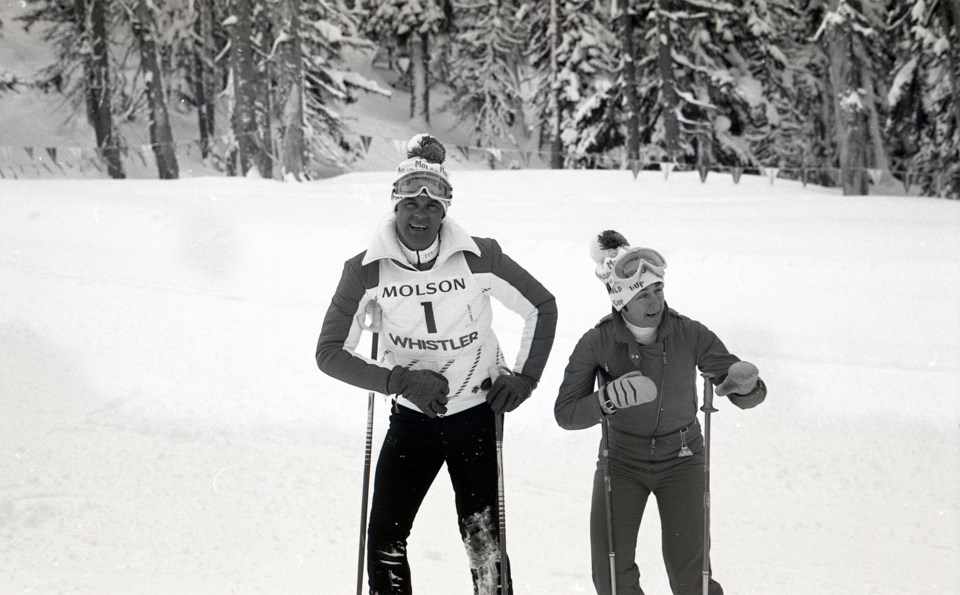Book learning may not be the first method that comes to mind when teaching someone to ski, but looking through the museum’s reference shelf you’ll find multiple examples of publications aiming to improve skiers’ technique and ability, often attached to at least one notable name. One such book is Ski with Toni Sailer in Flip Vision Photographs from 1964, though the copy at the museum is a reprint from 1967.
Toni Sailer, born in Austria in 1935, became the first ski racer to sweep all three disciplines at the Olympic Winter Games in 1956 when he won the downhill, slalom, and giant slalom in Cortina d’Ampezzo, Italy, at the age of 19. Sailer acted (and skied) in films, recorded albums, developed business interests in ski equipment and clothing, worked for the Austrian Skiing Association, was named “Austrian Sportspersonality of the Year” from 1956 to 1958, and later “Austrian Sportspersonality of the Century.” He also won four gold medals in world competitions before retiring from ski racing in 1959, and was awarded the Olympic Order in 1985. Around Whistler, however, he might be best known for his work with the summer ski camps on Whistler Mountain beginning in 1967.
Whistler Mountain hosted its first summer ski camp in 1966, the summer after the mountain opened to skiers. The camp offered coaching to intermediate and advanced skiers, as well as junior racers. From 1967, the Racing Camp was run under the personal direction of Toni Sailer, described by Garibaldi’s Whistler News as “one of the greatest Alpine racers of all time.” Skiers aged nine to 20 came to Whistler Mountain to train with Sailer, and the camp became known as the Toni Sailer Summer Ski Camp (the camp’s wooden sign is currently on display at the Whistler Museum). Over the years, other notable names came to coach on Whistler Mountain as well, including Nancy Greene, Wayne Wong, and Crazy Canuck Dave Murray, who took over direction of the camp in 1984.
While not as hands-on as coaching at the summer ski camps, Ski with Toni Sailer is an interesting (and often entertaining) look at Sailer’s approach to skiing. Costing only $1 in 1967 (adjusted for today, that would be just under $9), the book is meant to supplement rather than replace formal instruction, and readers are encouraged also to visit a “reputable certified ski school.”
Ski with Toni Sailer opens with the statement, “Skiing is the superlative of all sports,” and goes on to say that “skiing is more than just a sport. It is a way of life, an addiction that becomes a part of you.” After making it clear there is no minimum or maximum age required to ski (Sailer describes his father introducing him to the sport at the age of two), the book moves to practical matters such as picking the right equipment and clothing. Though much of this advice has changed over the past 60 years as skis have gotten shorter and clothing designs have evolved, some, like tips on how to grip your ski poles, appear to be timeless.
After stretches and strengthening exercises, the skier is led onto the hill and instructed on how to walk and turn on their skis. This is followed by chapters dedicated to specific techniques such as snow-plow turns, sideslipping, and slalom. Perhaps the best part of the book are the Flip Vision photographs that accompany these chapters. Skiers can watch Toni Sailer demonstrate 12 different techniques “as you would view a motion picture” simply by flipping the pages before trying them out themselves.
While this is not the only flip book produced to teach skiing, today the ease of making, viewing, and sharing videos means books are an uncommon method of teaching the sport. If, however, you’re interested in perfecting your technique by seeing how Toni Sailer did it, come by and check out the museum’s reference section.




